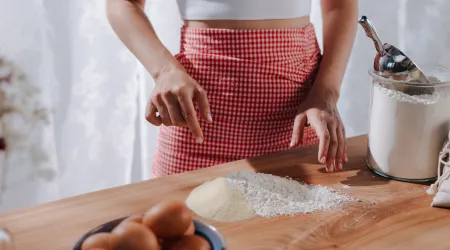How to make fresh homemade pasta

There fresh homemade pasta It is the beating heart of the Italian culinary tradition, a symbol of authenticity and love for cooking.
Announcements
Preparing it is not just a technical skill, but also a ritual that encompasses history, culture, and the pleasure of sharing special moments around the table.
In an increasingly frenetic world, making fresh pasta represents a return to basics, an experience that celebrates the simplicity and value of handmade products.
Despite its apparent ease, making flawless fresh pasta requires attention to detail, knowledge of ingredients, and a good dose of patience.
This article will guide you step by step through the preparation, providing practical advice, historical curiosities, and tricks to achieve results worthy of a true Italian chef.
Announcements
The ingredients: simplicity and quality
Choosing the right ingredients is the first step to creating truly extraordinary fresh homemade pasta.
The combination of flour and eggs may seem basic, but the quality of these elements makes all the difference.

Type “00” flour is ideal for obtaining a thin and elastic pastry, while fresh organic eggs guarantee an authentic flavor and golden color.
An interesting alternative is the use of durum wheat semolina, particularly suitable for shapes such as orecchiette or cavatelli.
This type of flour gives the pasta a rougher texture, perfect for holding sauces.
Furthermore, some regional recipes call for the addition of water instead of eggs, as in the case of Apulian pasta.
The conscious choice of ingredients
According to a study conducted by the University of Bologna in 2024, 65% of Italians prefer to buy flour from local mills to support the local economy and ensure freshness.
This data reflects the growing attention towards sustainability and the valorization of indigenous products.
A practical example: if you live in an area with a strong agricultural tradition, look for locally produced flours. Besides supporting local producers, you'll be able to experience unique flavors that will enrich your fresh pasta.
The technique: knead with mastery
The dough is the heart of making fresh homemade pasta. Proper kneading means working the ingredients until they form a smooth, elastic dough.
The movement must be firm but fluid: push with the palm of your hand and fold the dough over itself.
A common mistake is adding too much flour while kneading. This can make the dough too tough and difficult to roll out.
If the dough is sticky, just lightly dust the pastry board with flour, but don't overdo it.
Knead by hand or with a stand mixer?
Although kneading by hand is the traditional method, many today use mixers or planetary mixers to speed up the process.
However, kneading by hand allows you to better perceive the consistency of the dough and develop a deeper connection with the ingredients.
A practical example: if you're short on time but still want to maintain a traditional approach, you can start the dough with a stand mixer and finish it by hand to perfect the texture.
Rest: a crucial step
After kneading thoroughly, it's essential to let the dough rest. This step allows the gluten to relax and makes the dough easier to roll out without breaking.
Cover the dough with plastic wrap or wrap it in a damp cloth to prevent it from drying out.
The ideal resting time is at least 30 minutes at room temperature. However, if you need to prepare the dough in advance, you can store it in the refrigerator for up to 24 hours.
Rest and temperatures
According to the experts at the Italian Academy of Cuisine, dough should never rest in an environment that's too cold or too hot. A stable temperature between 20°C and 25°C is optimal for perfect results.
A practical tip: if you live in a warm climate, you can let the dough rest near an open window or in a well-ventilated room.
The drafting: precision and patience
Rolling out the dough is perhaps the most challenging step in making fresh homemade pasta. Using a rolling pin requires strength and precision to obtain thin, even sheets.
For those who prefer modern tools, a pasta machine can be a valuable ally.
A helpful trick is to divide the dough into smaller portions before rolling it out: this makes the work easier and ensures greater uniformity in the thickness of the pastry.
The perfect thickness
Each pasta shape requires a specific thickness: tagliatelle must be thin but sturdy; ravioli require a delicate sheet that won't break during cooking; lasagna requires an intermediate thickness to support the weight of the sauce.
A practical example: if you are making stuffed ravioli, try to roll out the dough until it is about 1 mm thick.
This will ensure that the filling stays sealed well without compromising the structure of the ravioli.
Formats: Unlimited Creativity
The beauty of fresh homemade pasta lies in the ability to create custom shapes that suit your tastes and culinary needs.
From classics like tagliatelle and fettuccine to stuffed ravioli or layered lasagna, each shape tells a different story.
For example, pappardelle are ideal for rich sauces like wild boar ragù; orecchiette from Puglia pair perfectly with simple condiments like turnip greens; tortellini from Emilia are perfect in warm broths during the holiday season.
Regional formats
Each Italian region has its own typical fresh pasta shapes. In Liguria we find the "mandilli de saea“, very thin sheets of pasta similar to handkerchiefs; in Sardinia there are “culurgiones”, ravioli filled with potatoes and mint; in the Marche region, “vincisgrassi” stand out, a variant of lasagna rich in intense flavours.
A practical tip: experiment with lesser-known shapes from your region or try creating your own variations by adding spices or aromatic herbs directly to the dough.
Cooking: the finishing touch
Cooking fresh pasta requires attention to detail to preserve its flavor and texture.
Unlike dried pasta, it cooks quickly (2-4 minutes) in plenty of salted water brought to a lively boil.
A common mistake is overcooking: this compromises the delicate texture of the pastry. Always taste it during cooking to check that it's al dente.
Perfect pairings
Fresh pasta lends itself to simple sauces that enhance its natural flavor. Melted butter and sage are ideal for stuffed ravioli; fresh tomato and basil enhance light tagliatelle; traditional ragù complements robust pappardelle.
A practical example: prepare a quick sauce with fresh cherry tomatoes sautéed in extra virgin olive oil and garlic to accompany freshly made fettuccine.
Storage: Maintain freshness
If you want to preserve your fresh homemade pasta for later use, there are several practical options.
You can freeze it by placing it on floured trays before transferring it to freezer bags or dry it slightly by leaving it to air dry on clean tea towels.
Frozen pasta can be cooked directly without thawing; dried pasta should be stored in airtight containers away from sources of humidity.
Conclusion
Prepare the fresh homemade pasta It's not just a culinary exercise: it's a journey through Italian culture that celebrates tradition, creativity, and a love of good food.
With a few fresh ingredients and precise techniques, anyone can become a master of the art of fresh pasta.
Whether you want to impress your guests with elegant ravioli or indulge yourself with simple tagliatelle with butter and sage, this practice will allow you to bring the true flavor of Italy to your table.
All that's left to do is get your hands dirty!
Frequently Asked Questions (FAQ)
How long can I keep fresh pasta?
Fresh pasta can be stored in the refrigerator for up to 2 days or frozen for up to 3 months. Be sure to use airtight containers or freezer bags.
Can I use alternative flours?
Yes! You can experiment with whole-wheat or gluten-free flours (like rice flour), adjusting the proportions of the ingredients to obtain balanced doughs.
What's the best sauce for fresh pasta?
It depends on the shape! For stuffed ravioli, we recommend melted butter and sage; for tagliatelle, light sauces like fresh tomato; for pappardelle, a full-bodied ragù.
Is it necessary to have a pasta machine?
No! While it's useful for rolling out even sheets of dough, you can achieve excellent results even with a simple rolling pin using traditional techniques.
